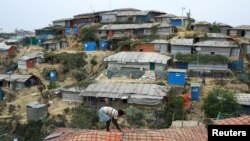Myanmar became independent in 1948 from the British rule. Since then the Rohingya Muslims, a minority religious group in Rakhine state of Myanmar were kept as a neglected ethnic group. Even in the democratic elections in November 2015, Muslims from Rakhine were neither allowed to participate as candidates, nor as voters – unlike in all previous elections since independence in 1948.
The Burmese authorities had always suppressed the Muslims in Rakhine. The Rohingyas always looked for a safe place to avoid the oppression of Burma. They began to migrate to neighboring Bangladesh in small groups, since 1970s.
At some stage, the oppressions of Myanmar authorities became so unbearable that a rebel organization called Arakan Rohingya Salvation Army (ARSA) was formed. In the name of protecting the Rohingya Muslims, and on August 25, 2017 they attacked the Myanmar’s Security forces. Responding to that attack, the Myanmar authorities unleashed their brutal actions, which was termed by the United Nations as ‘ethnic cleansing’. Thousands of Rohingya Muslims were killed, hundreds of Rohingya women raped, and their villages were burnt.
The helpless Rohingyas started fleeing the Rakhine state to save their lives. Many of them crossed the Naaf river took shelter in unknown jungles and hills of Cox’s Bazar, Bangladesh. As the atrocities and oppression on Rohingyas increased the influx of fleeing Rohingyas amplified by multiple numbers.
Since August 25, 2017 more than 7 hundred thousand Rohingyas, fled Myanmar and took shelter in Bangladesh. They found Bangladesh, their closest neighbor, as a safe place to live. They joined the three hundred thousand Rohingyas living in various camps who came earlier.
Not only the Muslims, few hundreds Hindus also had to flee from Rakhine state to avoid the brutality of the Myanmar security forces and for safety. They have taken also taken shelter in the Cox’s Bazar refugee camps.
The government of Bangladesh welcomed the Rohingya refugees and built camps in the hilly lands of Cox’ Bazar. Local people of Cox’s Bazar and adjacent areas, various national and international aid and voluntary organizations and the UN extended their help for the hopeless Rohingyas.
The Prime Minister of Bangladesh Sheikh Hasina visited Cox’s Bazar Rohingya camps on September 12, 2017 and she assured their safety and security.
It has been more than a year since the Burmese military began a violent campaign to force ethnic minorities to leave Myanmar's Rakhine state. Described by the UN as ethnic cleansing, witnesses say the military campaign to forcibly remove Rohingya populations from Myanmar included razing villages and separating families. More than 25 thousand were killed and thousands of women and girls were sexually assaulted. Since then, more than 700,000 Rohingyas have fled to neighboring Bangladesh to escape the violence. Many have settled in refugee camps along Bangladesh's Southeast coast. One such camp is near a small town called Cox's Bazar, where VOA Bangla reporter Selim Hossain spoke to some of the women who survived the purge.
Rohingya issue became an international issue of concern and drew the attention of the United Nations, European Union, the USA, Africa and the world.
World’s largest refugee influx became the headlines of international press and digital media, social media. Aid agencies, United Nations, voluntary organizations, NGOs, and individuals extended their hands of cooperation, for helping the Rohingyas.
The International community began pressing the Myanmar’s authorities to solve the crisis. Journalists and observers were not allowed to go to Rakhine state to see the real situation there. Three journalists were arrested and sentenced by the Myanmar government. This action was condemned by the international community as well.
On November 23, 2017, an agreement was signed between Myanmar and Bangladesh to solve the crisis. According to the agreement, Myanmar agreed to take all Rohingya refugees back to Myanmar after checking their proper identities. The agreement is still to be implemented and preparation is still on for the repatriation process.
The international community criticized the role of Aung San Suu Kyi the de facto leader of Myanmar for her failure to solve the crisis. Eminent international personalities including three Nobel prize laureates, UN Secretary General Antonio Gutierrez, US Government top adviser Lisa Curtis, VOA Director Amanda Bennett, visited the Rohingya camps in Cox’s Bazar and urged the international community to come forward to solve the crisis by creating pressure on Myanmar Government to take back the Rohingya refugees by ensuring their safety in Myanmar.
Meanwhile, the Rohingyas are living under inhuman conditions in Cox’s Bazar’s unhealthy and rain-soaked filthy refugee camps. They lack food, pure drinking water and medicine. Moreover, the heavy rain, storm and other natural disasters are causing them to fight similar struggle they experienced in Rakhine state. Still, they are passing every moments in the camps with hope and luck.
The government of Bangladesh recently announced that a temporary shelter has been built at BHASANCHAR, an Island near Hatia Upazilla for the Rohingyas. The government hopes to move one hundred thousand refugees from Cox’s Bazar camps.
The aid agencies are distributing food and other essentials to the refugees everyday as you can see behind me. However, many of them complained they are not getting relief materials as they are supposed to. They said, instead they get some help after about a month. They said nobody knows, why.




